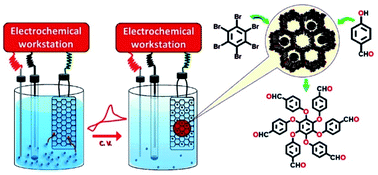A covalent organic framework with electrodeposited copper nanoparticles – a desirable catalyst for the Ullmann coupling reaction†
Abstract
A covalent organic framework is a porous covalently-linked polymeric assembly built from molecular lego blocks, the monomers. A COF's high surface area, ordered pores, and intrinsic low density makes it a perfect heterogeneous catalyst component. Dispersing catalytic metal nanoparticles into the porous COF matrix in a ‘capping-agent-free’ manner can aid the maximal utilization of the active sites. To generate single-site catalysts, metals have been anchored to dense supports, or metal ions have been coordinated to the porous organic framework. The latter has superior atom efficiency and a substrate diffusion advantage. Stably nestling neutral metallic clusters into open-framework supports with no specifically strong binding groups requires a different approach. If infused from extremely dilute electrolytes, metal clusters can be nanoconfined into electrically activated COFs. At low-loadings, it can resemble a single-site catalyst with high atom efficiency. Herein, we report the larger scale synthesis of IISERP-COF15 and electrochemical loading of copper nanoparticles into its pores at loadings as low as 3.34 wt%. We employed classical Ullmann reactions to adjudge its activity. Typical turnover numbers for the catalysts reported in the literature are approximately 50–100. A Cu@COF shows high activity with a very low catalyst loading of 0.25 mol% (TON around ∼300–350 vs. 4 for neat CuCl2·2H2O (homogeneous catalyst) and turnover frequency (∼15–17 h−1)). We recycled it for up to 3 cycles. Furthermore, we report a multi-fold Ullmann reaction producing an unreported hexaaldehyde to demonstrate the latitude of the catalyst. Our work points to the potential of a dilutely loaded metal@COF as a mimic of the single-site catalyst for synthesizing valuable C–O linked molecules. Our findings from computational modeling shed light on the role of the COF as an active nanoporous support for Ullmann C–O coupling.

- This article is part of the themed collection: Single-Atom Catalysis


 Please wait while we load your content...
Please wait while we load your content...